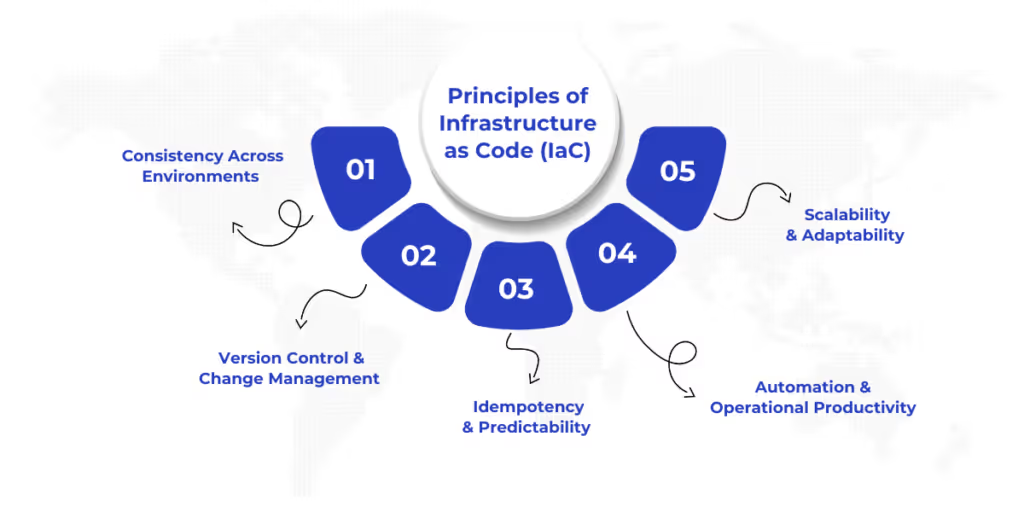

Managing infrastructure manually is time-consuming, inconsistent, and prone to human error. Configurations drift, deployments become unpredictable, and troubleshooting turns into a tedious process. As businesses scale, these inefficiencies compound, leading to downtime, security vulnerabilities, and operational bottlenecks.
Traditional infrastructure management struggles to keep pace with modern development cycles. Teams spend valuable time provisioning resources, updating configurations, and ensuring system stability—often repeating the same tasks across multiple environments. This slows down innovation and increases the risk of misconfigurations.
To address these challenges, organizations are shifting toward a more structured, automated approach. One that eliminates repetitive tasks, enforces consistency and enhances security without adding complexity.
In this blog, we will explore how IaC solves these problems, its key benefits, and why it has become a critical component of modern IT operations.
Infrastructure as Code (IaC) is a method of managing IT infrastructure through code instead of manual processes. It replaces manual configurations with machine-readable scripts, ensuring that resources like servers, networks, and storage are provisioned and managed consistently across environments.
With IaC, infrastructure management becomes:
By treating infrastructure like software, teams can version control, test, and deploy changes seamlessly. This approach improves efficiency, enhances security, and ensures that infrastructure scales with business needs.
To implement Infrastructure as Code effectively, it's important to understand how configurations are defined and applied. IaC follows two primary approaches.
Both these approaches define how infrastructure should be managed, but they differ in execution and flexibility. Understanding these approaches helps teams choose the right strategy for their needs.
Declarative vs Imperative approach
ApproachDefinitionHow It WorksUse CaseDeclarativeDefines the desired end state of the infrastructureThe system automatically determines the steps to achieve the target stateBest for maintaining consistency and large-scale automationImperativeSpecifies step-by-step instructions to reach the desired stateRequires executing commands in a specific orderBest for fine-grained control and configuration management
The declarative approach focuses on what the final infrastructure should look like, making it ideal for automation and large-scale deployments. The imperative approach emphasizes how to achieve that state, offering more control but requiring manual intervention.
Both approaches have their advantages, and in practice, organizations often use a combination of both depending on their infrastructure needs.
Regardless of the approach, the effectiveness of IaC depends on core principles that ensure the infrastructure remains scalable, reliable, and easy to manage. Let’s explore them in detail.

Implementing IaC goes beyond automating infrastructure—it requires adherence to key principles that ensure consistency, security, and scalability. These principles form the foundation of a well-structured and maintainable IaC practice. Key principles of IaC include the following:
By following these principles, organizations can create resilient, easily manageable infrastructure. But what makes IaC truly valuable is the impact it has on IT operations. Let’s explore the key benefits it offers.
Adopting IaC brings tangible improvements in efficiency, security, and cost-effectiveness. By codifying infrastructure, organizations can eliminate repetitive tasks, improve collaboration, and ensure stability in their IT environments. Here are the key benefits of IaC:
While IaC simplifies infrastructure management, its adoption comes with challenges. In the next section, we’ll examine potential risks and obstacles organizations may face when implementing IaC.
While Infrastructure as Code (IaC) streamlines infrastructure management, its implementation comes with challenges. Security risks, configuration drift, and complexity in large-scale environments can create obstacles for teams. Addressing these challenges proactively ensures a more secure and efficient infrastructure.
To overcome these challenges, organizations must implement best practices and adopt the right tools. The table below outlines common challenges and their corresponding solutions.
Table: Challenges and Solutions for IaC Implementation
ChallengeSolutionSecurity RisksUse secrets management tools like HashiCorp Vault, implement IAM policies, and enforce automated security scans.Complexity in Large-Scale EnvironmentsUtilize modular IaC frameworks such as Terraform modules to simplify and reuse configurations.Configuration DriftEnforce automated monitoring with drift detection tools like AWS Config or Terraform Cloud.State Management IssuesStore state files securely using remote storage solutions like Terraform Cloud, AWS S3, or Azure Blob Storage.Learning Curve and AdoptionProvide hands-on training, set coding standards, and implement peer reviews to ensure best practices.
By addressing these challenges early, organizations can enhance the security, reliability, and efficiency of their IaC implementations. Moving on, we’ll discuss the tools that can further optimize IaC strategies and ensure long-term success.
Infrastructure as Code (IaC) tools streamline the deployment, management, and scaling of infrastructure. Different tools serve specific functions, from provisioning resources to configuring systems and orchestrating deployments. Here are some widely used IaC tools and their primary use cases.
Each tool plays a distinct role in IaC workflows, helping teams automate infrastructure provisioning, enforce consistency, and optimize resource management. Next, we’ll explore the real-world applications of IaC and discuss its future potential.
Infrastructure as Code (IaC) has transformed how organizations manage and scale infrastructure. Its applications extend beyond simple automation, enabling efficiency, security, and agility in modern IT environments. As technology evolves, the future of IaC will continue to drive innovation in cloud computing, DevOps, and beyond.
As organizations increasingly adopt automation, the role of IaC will continue to evolve, driving efficiency, security, and scalability.
Infrastructure as Code (IaC) has revolutionized infrastructure management by enabling automation, consistency, and scalability. It eliminates manual provisioning, reduces human error, and integrates seamlessly with DevOps workflows. As technology evolves, IaC will continue to play a crucial role in cloud computing, security automation, and scalable IT operations. With the right strategy, IaC empowers teams to build resilient, future-ready infrastructure.
That’s where WaferWire comes in. We provide tailored Infrastructure as Code (IaC) strategies designed to meet the unique needs of your business. Here’s how we can help:
Let WaferWire help you take your IT infrastructure to the next level.
Ready to future-proof Your IT Operations?
Contact us today to explore how we can help transform and drive your business forward!

